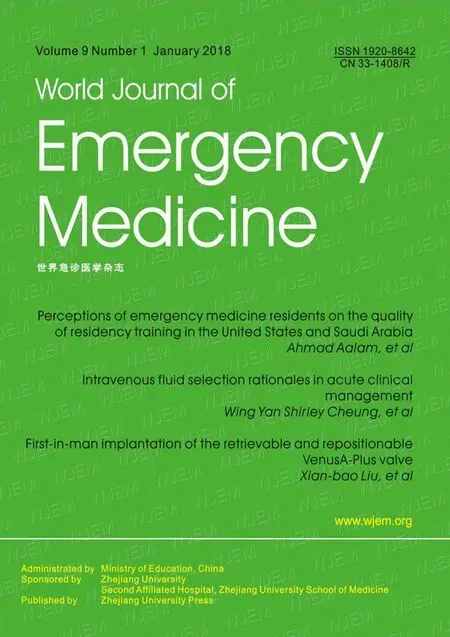Understanding the effect of propofol and electrical cardioversion on the systolic blood pressure of emergency department patients with atrial fibrillation
David R. Vinson, Bory Kea
1 The Permanente Medical Group and Kaiser Permanente Division of Research, Oakland, California, USA
2 Department of Emergency Medicine, Oregon Health and Science University, Portland, Oregon, USA
Dear editor,
We read with pleasure the well-designed study by Butler et al of electrical cardioversion of emergency department patients with atrial fibrillation.[1]We appreciate their analysis of the distinctives of procedural sedation when employed for this indication. Understanding the dosing adjustments to propofol undertaken by their sedationists will help us more carefully evaluate our own approach to sedating patients undergoing electrical cardioversion of atrial fibrillation.
The greater incidence of hypotension in the cardioversion group in relation to the comparators (27.6%vs. 16.5%,P<0.001) despite the significantly lower doses of propofol and fentanyl deserves comment. The two cohorts were different in several ways. As the authors point out, the atrial fibrillation patients undergoing electrical cardioversion were older than their non-cardioversion counterparts and had a greater comorbidity burden. It is likely that attending these differences in clinical profiles were variations in pre-arrival pharmacotherapy, which may also have had a bearing on blood pressure responses to propofol administration and electrical cardioversion.
But there are several key pre-sedation variables missing from the analysis that would help us understand the context of the hypotension that developed during the patients’ emergency department management. Many patients seeking emergency care for atrial fibrillation present with a rapid ventricular response. This alone may be associated with a lower systolic blood pressure,even before the administration of sedation medications.Moreover, this rapid ventricular response is often treated with atrial-ventricular nodal blockers, like nondihydropyridine calcium channel blockers and/or betaadrenergic blockers.[2,3]These medications can also reduce systolic blood pressure and may compound the vasoactive effects of sedation medications.[4,5]It would provide readers a more comprehensive picture of the associated risks of procedural sedation if the authors reported the following: (1) the presenting systolic blood pressures; (2)the pre-sedation rate-reduction medications received by their cardioversion cohort; and (3) an evaluation of the associations between rate-reduction medication reception and subsequent hypotension. This supplemental analysis will serve to enhance the impact of the study.
1 Butler M, Froese P, Zed P, Kovacs G, MacKinley R, Magee K,et al. Emergency department procedural sedation for primary electrical cardioversion - a comparison with procedural sedations for other reasons. World J Emerg Med. 2017;8(3):165-9.
2 Stiell IG, Clement CM, Rowe BH, Brison RJ, Wyse DG, Birnie D, et al. Outcomes for emergency department patients with recent-onset atrial fibrillation and flutter treated in Canadian hospitals. Ann Emerg Med. 2017;69(5):562-71 e2.
3 Vinson DR, Hoehn T, Graber DJ, Williams TM. Managing emergency department patients with recent-onset atrial fibrillation. J Emerg Med. 2012;42(2):139-48.
4 Fromm C, Suau SJ, Cohen V, Likourezos A, Jellinek-Cohen S, Rose J, et al. Diltiazem vs. Metoprolol in the management of atrial fibrillation or flutter with rapid ventricular rate in the emergency department. J Emerg Med. 2015;49(2):175-82.
5 Hines MC, Reed BN, Ivaturi V, Bontempo LJ, Bond MC,Hayes BD. Diltiazem versus metoprolol for rate control in atrial fibrillation with rapid ventricular response in the emergency department. Am J Health Syst Pharm. 2016;73(24):2068-76.
 World journal of emergency medicine2018年1期
World journal of emergency medicine2018年1期
- World journal of emergency medicine的其它文章
- Perimortem caesarean section: A case report of an out-of-hospital arrest pregnant woman
- Drug calculation ability of qualified paramedics:A pilot study
- Ischemic stroke due to carbon monoxide intoxication:Two case reports
- A Lazarus effect: A case report of Bupropion overdose mimicking brain death
- First-in-man implantation of the retrievable and repositionable VenusA-Plus valve
- Dose-related effects of dexmedetomidine on immunomodulation and mortality to septic shock in rats
